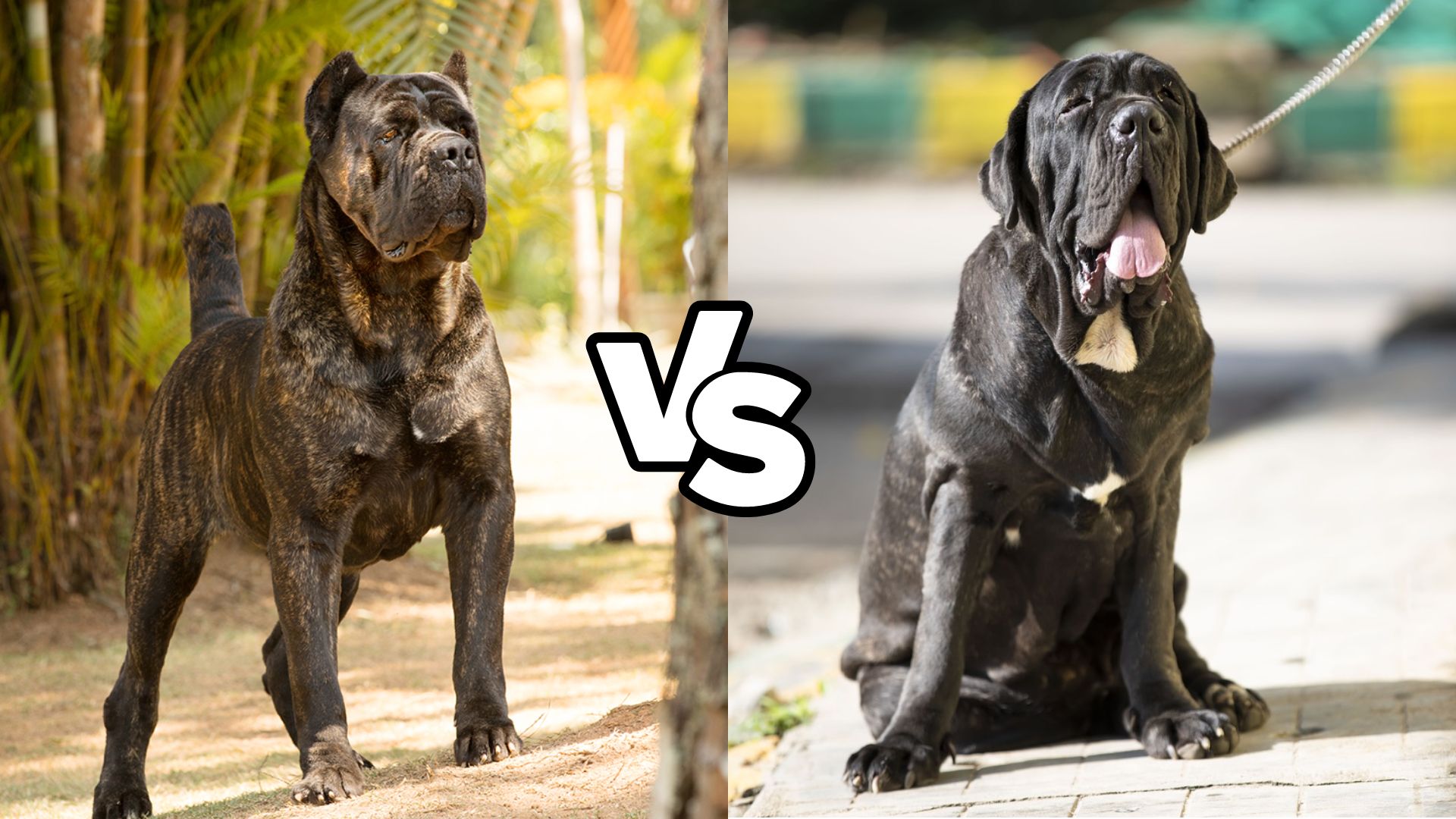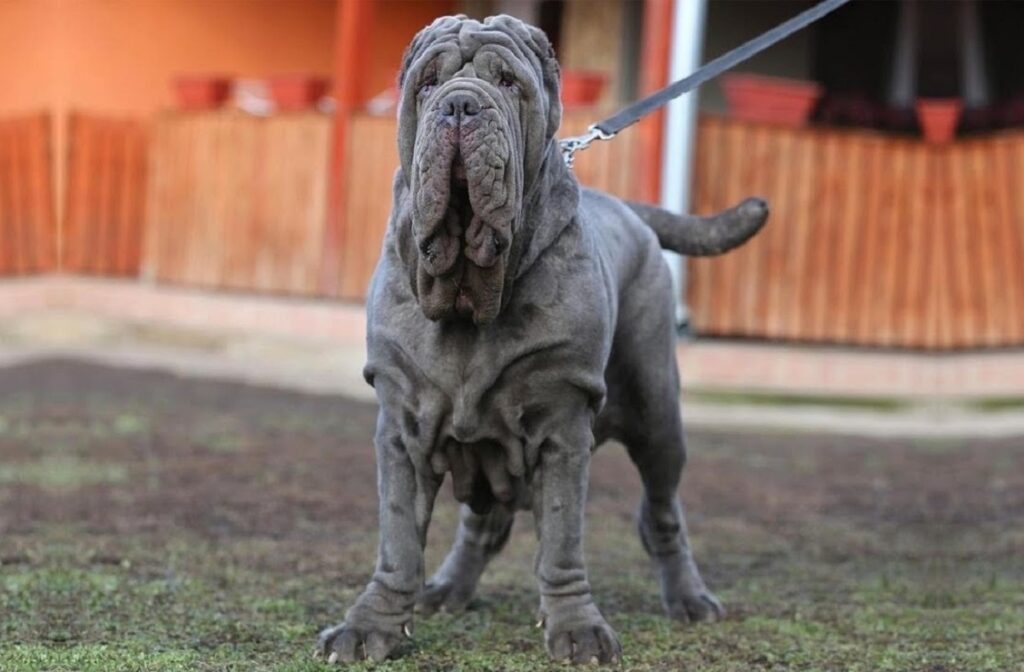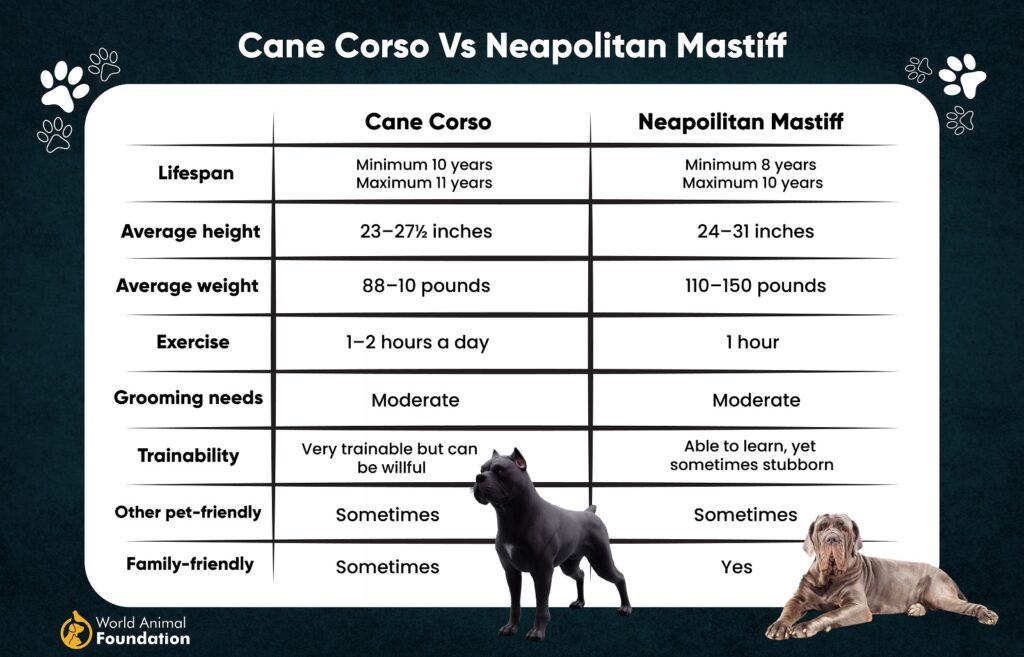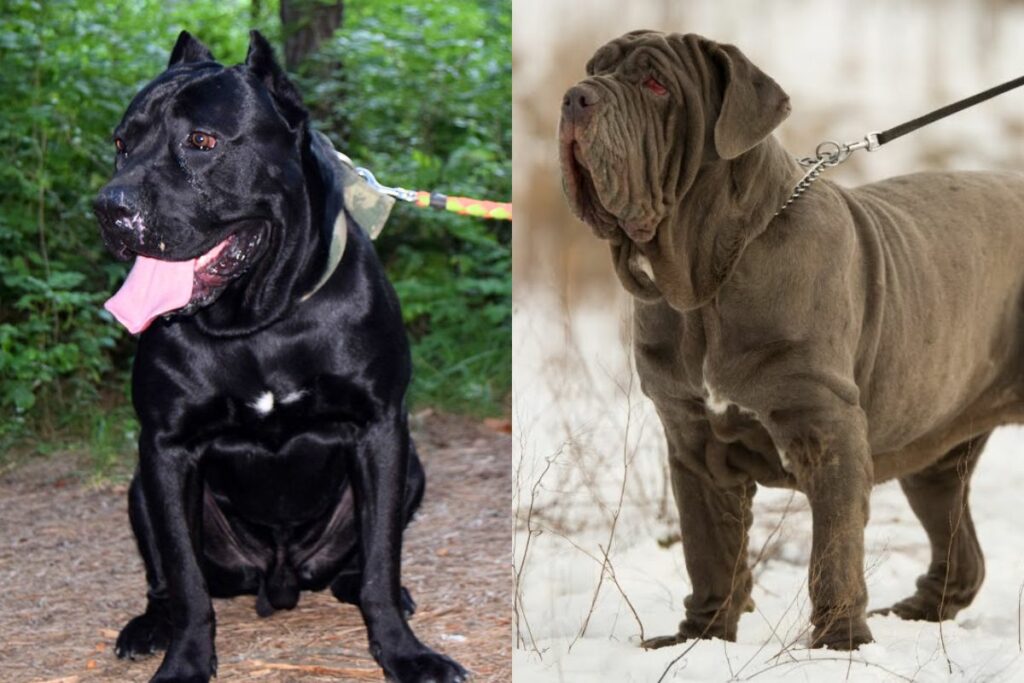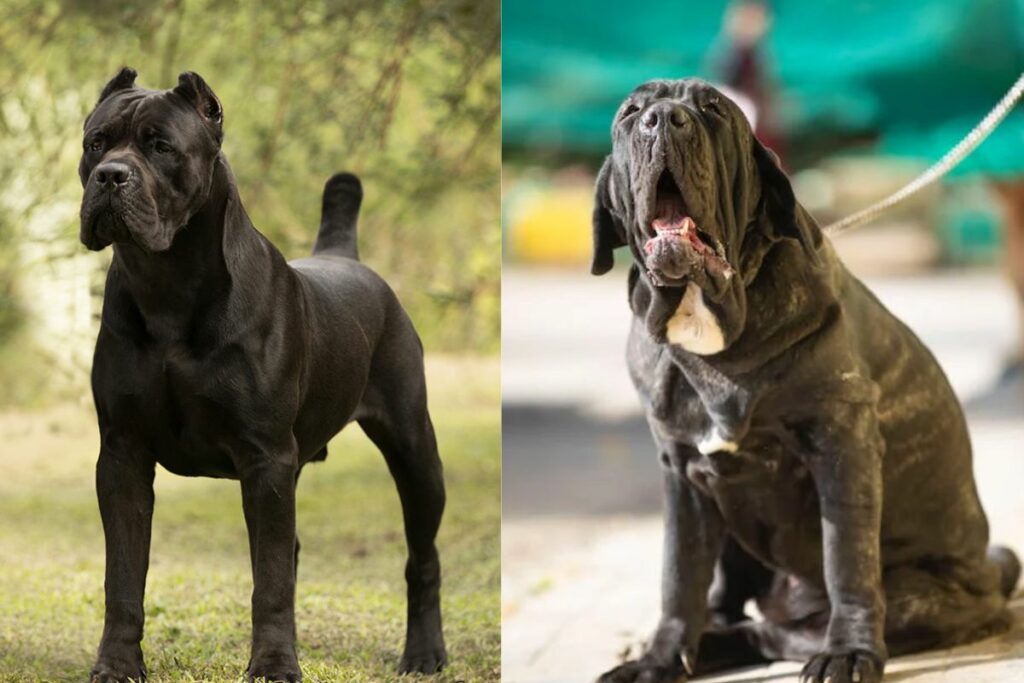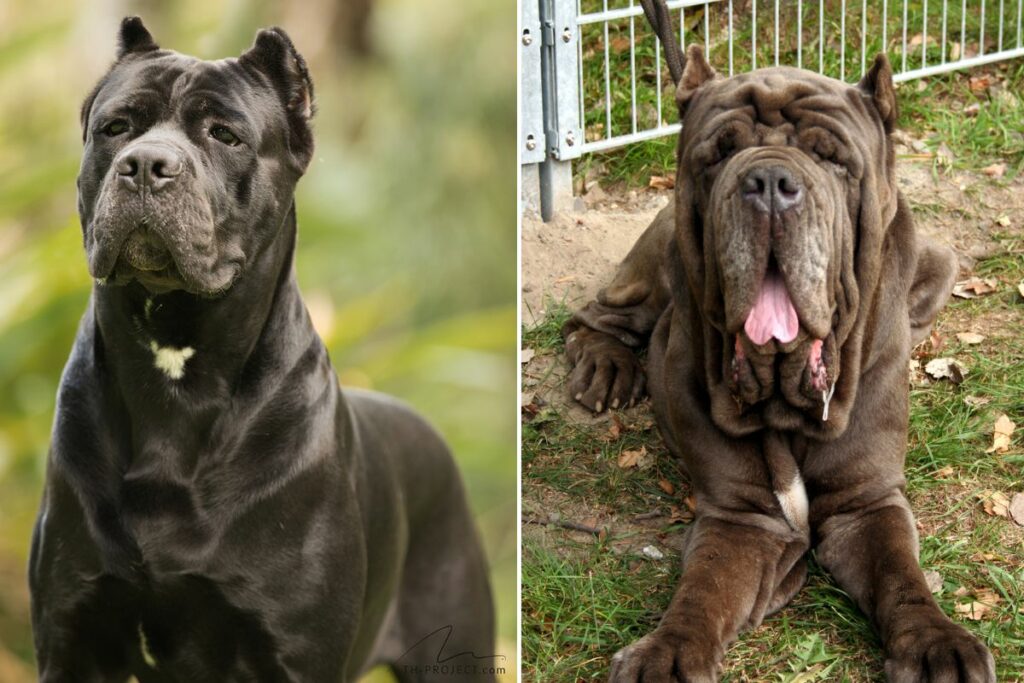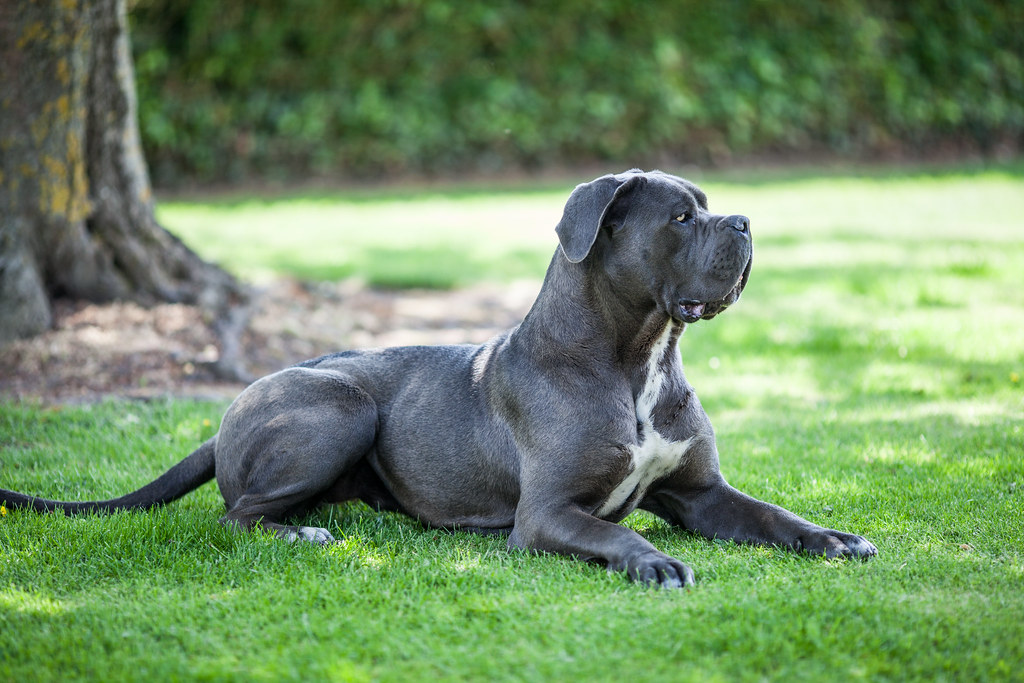The Cane Corso and Neapolitan Mastiff, two imposing breeds often met with apprehension, are more than their powerful physiques. Behind the furrowed brows and weighty jowls lie intelligent, loyal companions. Misunderstood and sometimes misrepresented, these gentle giants crave connection and purpose. This exploration delves into the distinct characteristics of each breed, separating fact from fiction, and revealing the devoted hearts beating beneath their formidable exteriors. Discover the nuances that distinguish these majestic dogs and learn why, for the right owner, they offer unmatched devotion and unwavering protection.
If dogs could be football players, Cane Corsos and Neapolitan Mastiffs would be the huge guys on the defensive line. It’s due to their size that so many are intimated by the breeds.
But how are they different? Alike? That’s what we’re investigating. They have more in common than “Massive dudes,” and we’re excited to share those details.
Cane Corso vs Neapolitan Mastiff also brings to mind what they’re like in their temperaments. Are they completely aloof, or do they have a warm and fuzzy side?
As we talk about these breeds, do your best to keep an open mind. They’d certainly like it if you did. First, let’s get into their histories and learn the origins of these gorgeous dogs.
Cane Corso
This breed was developed in ancient Greece to be warrior dogs and brought to Italy to become guard dogs, watchdogs, and farm dogs. They’re considered to be “Molossus dogs,” meaning dogs of the Greek tribe and kingdom of the Molossian inhabitants. This guard dog is large with a broad chest, huge head, and great strength.
The name “Cane Corso” loosely translates from Latin to mean “bodyguard dog” or “robust dog.” And that they are good guard dogs!
They eventually became drovers (driving livestock, especially cattle) and hunters and as such, became quite diverse. Their muscular frame and endurance made them dogs with an excellent work ethic. You’d need to be if you hunted wild boar. They don’t call in sick much, and if they did, they would snort, howl, or “Woo-woo,” which are sounds they tend to make.
A sad part of their story is that these dogs are usually docked (tails) and cropped (ears) just to make them appear more scary-looking. Today, this breed is as misunderstood as pitbull terriers.
The Cane Corso was recognized as a breed by the AKC in 2010.
Neapolitan Mastiff
Named after Naples in Italy, the Neapolitan fended off some courtyard intruders simply by existing. They’re that formidable. Mastinos worked just as hard on farms, guarding livestock and people.
Horrifically, these fearless dogs’ ancestors fought other animals and people for entertainment purposes at the Colosseum.
Due to this Italian dog breed being ginormous and having deep folds of skin on their faces and bodies, Neapolitan Mastiffs can look a bit, well… scary! If you meet one though, you’ll probably think differently.
In 1946, postwar, Italian dog fanciers held a dog show where eight ancestors of the Neapolitan were shown. One caught the eye of journalist Piero Scanziani as he remembered the Molosser dogs of the past.
The dog, Guaglione, was acquired by Scanziani and eventually bred into what is today known as the Neapolitan. His beloved dog became the model for the initial breed standard.
We must mention that this ancient Italian breed faced extinction during the World Wars and became almost unheard of until the 1970s when fanciers took notice.
Mario Querci, a textile maker from Tuscany, pushed to have the folds that identify the Neopolitan so well even more pronounced. In 1992, one of his dogs won the World Dog Show in Valencia, Spain.
Today, the American Kennel Club (AKC) says there has been an international effort to focus on the health of the Neopolitan rather than how many folds they have. Let’s hope that’s true.
In 1973, the first club for the breed was established, and they were officially recognized by the AKC in 2004.
Cane Corso vs Neapolitan Mastiff: What’s the Difference?
Now, let’s explore the distinct differences between the Cane Corso and the Neapolitan Mastiff, two majestic breeds with unique characteristics.
Classifications and standards
- Cane Corso – Working group classification
- Neapolitan Mastiff – Working group classification
BREED STANDARD
Cane Corso – (AKC) General appearance: A medium-large size Molossus dog that is sturdy with a strong skeleton. Athletic and muscular, he moves with ease and elegance. A large-boned dog, rectangular in proportion.
Neapolitan Mastiff – (AKC) General appearance: A stocky, heavy-boned dog. The loose skin over his entire body is abundant. With an enormous head and imposing size, he “rolls and lumbers” as he moves.
This is only a snippet of the breed standards for both the Cane Corso and the Neopolitan. You can find out more about them!
Common name
- Cane Corso – Cane Corso Italiano; Italian Mastiff
- Neapolitan Mastiff – Mastino Napoletano; Cani da presa or “catch dogs”
Coat
- Cane Corso – Double-layered with a smooth, short coat of many colors
- Neapolitan Mastiff – Double-coated with a smooth, short, dense coat no longer than one inch over the entire body
Color
- Cane Corso – Black, gray, fawn, black brindle, gray brindle, red, chestnut brindle
- Neapolitan Mastiff – Blue, black, mahogany, tawny
Minimum and maximum life span
- Cane Corso – 9-12 yrs.
- Neapolitan Mastiff – 7-9 yrs.
Average height
- Cane Corso: 25-27.5 inches (male)23.5-26 inches (female)
- Neapolitan Mastiff: 26-31 inches (male)24-29 inches (female)
Average weight
- Cane Corso: Proportionate to height (often more than 100 lbs.)
- Neapolitan Mastiff: 150 lbs. (male) 110 lbs. (female)
Personality
Cane Corso – This breed will catch on to your mood and sometimes mimic it or express empathy. Extremely loyal and protective (highly territorial), they’re certainly not Labradors when it comes to welcoming strangers or other dogs; instead, they can be aloof and dismissive. Other than that, they’re as “warm and fuzzy” as they come.
Neapolitan Mastiff – Loyal, intuitive, devoted, and loving, the Neapolitan Mastiff is sweet with family members. They are affectionate and have a gentle disposition. Also, they must be given strong leadership to ward off becoming stubborn and willful.
Note: Only with obedience training (positive reinforcement only) and proper socialization as puppies will both breeds portray the above characteristics.
Shedding
Cane Corso – The undercoat sheds throughout the year, especially during the spring.
Neapolitan Mastiff – The coat is short and smooth and will shed, not heavily except for twice yearly, but it really depends on the dog.
Training
Cane Corso – This breed needs consistent and positive reinforcement training. They don’t respond well to negative or harsh commands. So important…Start young. When they’re puppies, begin training so you won’t have a disobedient “train” roaming around.
The situation could quickly become dangerous with large dogs. Daily walks are necessary to help their physical and mental health.
Neapolitan Mastiff – Mastiffs need the same obedience training as described with the Cane Corso. All they need daily afterward is a couple of daily walks, or they have the propensity to get lazy and bored and can even become aggressive.
Continue obedience training as they age since it doesn’t need to stop as they get older.
Grooming needs and health
Cane Corso – Grooming: Since they do shed more than Neapolitans, weekly brushing is recommended, especially during the spring. Check eyes and ears regularly, too. (The perfect time would be when you’re brushing them.) You can clean the ears yourself with a vet-recommended cleaner, or a vet can take care of it for you. Keep their nails short at all times.
Cane Corso – Health: The following conditions need to be watched for with your Cane Corso:
- Hip dysplasia – Abnormal development of the hip
- Epilepsy – Seizure disorders
- Mange – Caused by mites
- Eyelid issues – Glandular hypertrophy (“cherry eye”)
- Bloat – Usually happens in dogs with deep chests.
- Skin infections
- Allergies
Neapolitan Mastiff – Grooming: With their short coats, a bath every now and then will suffice. Their eyes and ears need to be checked regularly. Remember their nails. Don’t forget to have a towel at the ready since they drool a lot, and you may not want that to be part of your decor.
Neapolitan Mastiff – Health: The following conditions need to be watched for with your Neapolitan who is generally healthy:
- Dental disease – One of the most common, chronic health issues for such dogs and especially for the Neapolitan.
- Bacterial and viral infections (parvo, rabies, and distemper – vaccinations are important)
- Obesity – Serious disease that can cause joint problems, digestive disorders, heart disease, and back pain.
- Parasites – Fleas, ticks, mites, worms, mosquitos, etc. Some parasites can be transmitted to humans (zoonotic).
- Bloat
- Eye issues – Cataracts, eyelid issues – Glandular hypertrophy (“cherry eye”)
- Musculoskeletal issues – Bone and joint problems
- Allergies
- Mange
- Skin infections
- Thyroid issues
- Retained testicle
- Cancer
One of the best ways to care for these great family pets is to have them spayed or neutered. This can prevent certain types of cancers and, of course, prevent them from having or fathering puppies. (There are too many homeless dogs as it is.)
Cost
- Cane Corso – From a breeder, look to pay $1,000–$3,000 for a healthy puppy.
- Neo – From a breeder, look to pay $2,000–$4,000 for a healthy puppy.
However, please check with your local rescue/shelter or breed-specific rescue first, since adoption is the best way to save the lives of dogs.
Prices for puppies can be affected by various factors:
- The state the breeder is located in and their reputation
- Lineage of the dog
- Pedigree of the dog
- If the dog will be a show dog or not
And more.
Suitable for
Both breeds:
- Families with no young/small children – Simply due to their abundant size, both breeds can be dangerous just being around kids.
- An assertive, self-assured guardian – These breeds can sniff out weakness and need strong leadership.
- Guardians with experience with large breeds – Although they might not flourish with amateur dog owners, if a first-time guardian has done their research on the breed and wants to keep their dog happy, stimulated, and socialized, go for it.
- Someone who knows how to train a massive breed or can find someone who does – If you’re more comfortable asking someone else to train them, make sure they have interactive training sessions between you and your dog.
Although these are only suggestions, there’s an exception to every rule; people with the above requirements would generally give a breed the best chance at a happy, healthy life.
FAQs
What dog is tougher than a Cane Corso?
The Kangal and Caucasian shepherd are both huge breeds that could give Cane Corsos a run for their money. There are others as well, but it mainly depends on a dog’s temperament and history, among other factors.
Is a mastiff bigger than a Cane Corso?
Yes, a mastiff is one of the largest dog breeds in existence.
What is the bite force of a Neapolitan Mastiff?
400-600 psi (per square inch) – But this largely depends on the individual dog.
Is a Cane Corso tougher than a pit bull?
Both breeds are tough mentally and physically, so there’s no way to pin down which one is tougher.
Final Thoughts
There you have it… Neapolitan Mastiff vs. Cane Corso! Two huge breeds that are incredibly intelligent and loyal. The key here is knowing if you’re the perfect person to be the proud guardian of one of these breeds. If you are, you’ll likely have a protective, slobbery lover on your hands.
Get ready to exercise a lot more, know how to be in charge, and obviously, grab a towel.
The Cane Corso and Neapolitan Mastiff, while sharing ancient lineage and imposing statures, are distinct breeds often unfairly categorized as aggressive. Understanding their unique temperaments and needs is crucial. While both require experienced, committed owners capable of providing firm, consistent training and socialization, the Cane Corso possesses a more active, athletic disposition. The Neapolitan Mastiff, while equally loyal, thrives on a calmer, more sedentary lifestyle. With proper care and understanding, both breeds can be devoted, loving companions, proving that their imposing appearances often mask gentle giants.

